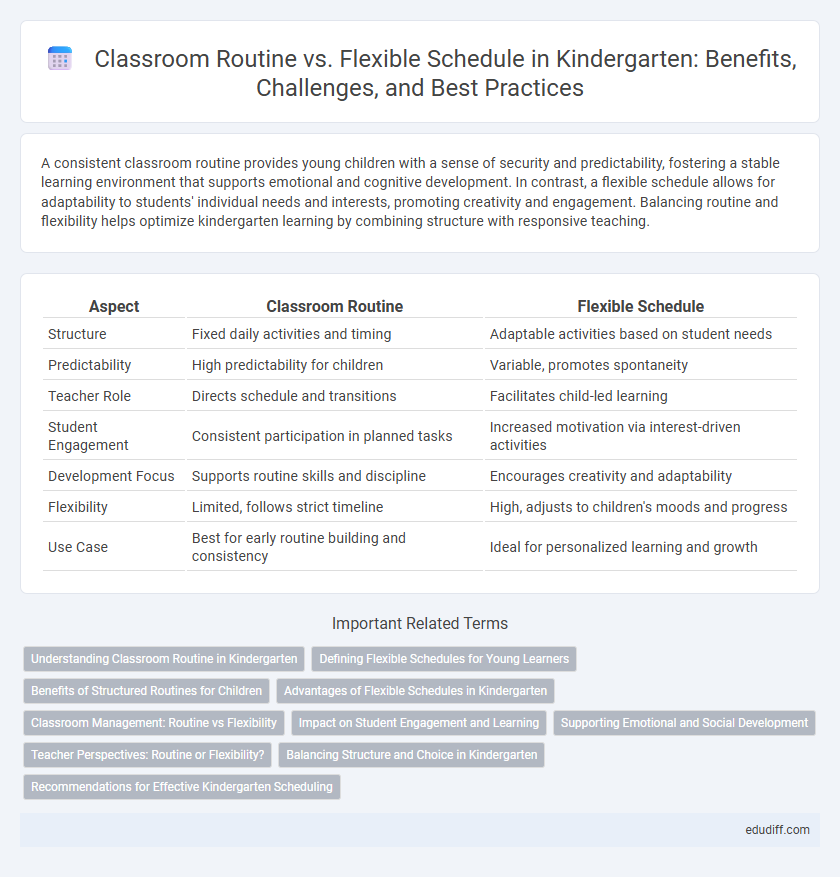A consistent classroom routine provides young children with a sense of security and predictability, fostering a stable learning environment that supports emotional and cognitive development. In contrast, a flexible schedule allows for adaptability to students' individual needs and interests, promoting creativity and engagement. Balancing routine and flexibility helps optimize kindergarten learning by combining structure with responsive teaching.
Table of Comparison
| Aspect | Classroom Routine | Flexible Schedule |
|---|---|---|
| Structure | Fixed daily activities and timing | Adaptable activities based on student needs |
| Predictability | High predictability for children | Variable, promotes spontaneity |
| Teacher Role | Directs schedule and transitions | Facilitates child-led learning |
| Student Engagement | Consistent participation in planned tasks | Increased motivation via interest-driven activities |
| Development Focus | Supports routine skills and discipline | Encourages creativity and adaptability |
| Flexibility | Limited, follows strict timeline | High, adjusts to children's moods and progress |
| Use Case | Best for early routine building and consistency | Ideal for personalized learning and growth |
Understanding Classroom Routine in Kindergarten
Classroom routine in kindergarten establishes a structured environment where children engage in consistent activities, promoting security and effective learning habits. Predictable sequences, such as circle time, snack breaks, and play periods, enhance cognitive and social development by providing stability. Teachers use routines to optimize transitions, reduce behavioral issues, and support young learners' emotional regulation.
Defining Flexible Schedules for Young Learners
Flexible schedules in kindergarten prioritize adaptability to children's individual needs, allowing variations in activity duration and sequence based on engagement and energy levels. This approach supports developmental milestones by accommodating spontaneous learning opportunities and encouraging autonomy in young learners. Unlike rigid classroom routines, flexible schedules enhance creativity and responsiveness in early childhood education environments.
Benefits of Structured Routines for Children
Structured routines in kindergarten provide children with a predictable environment that enhances their sense of security and supports emotional regulation. Consistent daily schedules improve cognitive development by allowing children to anticipate transitions and focus on learning activities. Clear routines also promote positive behavior, social skills, and independence by establishing clear expectations and fostering time management.
Advantages of Flexible Schedules in Kindergarten
Flexible schedules in kindergarten enhance children's autonomy by allowing them to engage in activities based on their interests and developmental readiness, promoting intrinsic motivation and deeper learning. This approach supports individualized attention from educators, facilitating tailored instruction that addresses diverse learning styles and paces. Moreover, flexible routines reduce stress and behavioral issues by accommodating natural energy fluctuations and fostering a nurturing, student-centered environment.
Classroom Management: Routine vs Flexibility
Effective classroom management in kindergarten balances a structured routine with flexibility to support young learners' development. A consistent routine provides stability and predictability, helping children feel secure and understand expectations, while a flexible schedule allows for spontaneous activities and adapts to children's varying attention spans and needs. This dynamic approach enhances engagement, minimizes behavioral issues, and fosters a positive learning environment tailored to individual growth.
Impact on Student Engagement and Learning
Classroom routines provide structure that enhances kindergarten students' sense of security and predictability, fostering consistent engagement and improving learning outcomes. Flexible schedules allow for adaptability to individual interests and energy levels, promoting creativity and personalized learning experiences. Balancing routine with flexibility optimizes student engagement by accommodating developmental needs and supporting diverse learning styles.
Supporting Emotional and Social Development
Classroom routines in kindergarten create a predictable environment that helps children feel secure and supported, promoting emotional stability and social confidence. Flexible schedules encourage adaptability and foster problem-solving skills, allowing children to engage in social interactions more naturally and express emotions effectively. Balancing structured routines with flexible periods supports comprehensive emotional and social development by catering to varying needs and promoting resilience.
Teacher Perspectives: Routine or Flexibility?
Kindergarten teachers often weigh the benefits of a structured classroom routine against the advantages of a flexible schedule, aiming to balance consistency with adaptability to meet children's diverse learning needs. Routine supports predictability, helping young learners develop security and focus, while flexibility allows educators to respond dynamically to students' interests and developmental cues. Teacher perspectives reveal a growing trend toward blending both approaches, optimizing engagement and fostering a responsive learning environment.
Balancing Structure and Choice in Kindergarten
Balancing structure and choice in kindergarten involves combining a consistent classroom routine with opportunities for flexible scheduling to support children's developmental needs. A well-established routine fosters a sense of security and predictability, helping young learners develop self-regulation and time management skills. Incorporating flexible periods allows children to engage in creative play, exploration, and personalized learning, promoting autonomy and motivation within the structured environment.
Recommendations for Effective Kindergarten Scheduling
Effective kindergarten scheduling balances structured classroom routines with flexible schedules to support diverse learning needs and developmental stages. Implementing consistent time blocks for key activities like literacy, play, and rest enhances predictability, while allowing flexibility accommodates individual attention and spontaneous learning moments. Prioritizing transitions, minimizing downtime, and incorporating teacher input leads to a dynamic schedule that fosters engagement and social-emotional growth.
Classroom Routine vs Flexible Schedule Infographic

 edudiff.com
edudiff.com